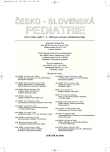The Practical Significance of Non-cholesterol Sterols during Monitoring of Drug Treatment of Familial Hypercholesterolemia in Children and Adolescents
Význam plazmatických necholesterolových sterolů při monitorování medikamentózní léčby dětských a adolescentních familiárních hypercholesterolémií
Cíl:
Určit praktický význam stanovení markerů endogenní syntézy cholesterolu a fytosterolů během monitorování medikamentózní léčby familiárních hypercholesterolémií (FH)u dětí a adolescentů.
Metody:
Lathosterol (Lat), desmosterol (Des), lanosterol (Lan), kampesterol (Cam) a sitosterol (Sit) byly stanovovány pomocí GC/MS v plazmě zdravých i nemocných dětí během jejich návštěvy v metabolické ambulanci v letech 2003–2005; výsledky byly srovnány s dospělými pacienty a zdravými dárci.
Výsledky:
U 160 dětí ve věku 6–18 let (50 % zdraví a 50 % s FH) byly stanovovány hlavní markery endogenní syntézy cholesterolu (Lat, Des, Lan) a fytosterolů (Cam a Sit) během nízkocholesterolové dietní léčby stejně jako během léčby iontoměniči, statiny a statiny kombinovanými s ezetimibem. Byly určeny referenční hodnoty těchto metabolitů u různých věkových skupin zdravých dětí, které nejsou závislé na pohlaví ani věku. U dětí na přísné dietní léčbě byly hladiny Lat a Des zvýšeny i po dosažení léčebné hladiny celkového cholesterolu. Stejný trend byl patrný také u dětí léčených statiny. Léčba iontoměniči a statiny kombinovanými s ezetimibem snižovala hladiny prekurzorů. Fytosteroly v plazmě nebyly závislé na hladinách cholesterolu ani na věku a pohlaví dětí. Jejich výrazné zvýšení autoři pozorovali po podávání iontoměničů a ezetimibu. Domnívají se, že pacienti s vysokými hladinami Lat jsou vhodní pro léčbu statiny, pacienti s vysokým Cam pro léčbu ezetimibem nebo stanoly. Extrémně vysoké hladiny Lat nebo Cam dovolují určit „hyperrespondery“ pro dietní či medikamentózní léčbu.
Závěry:
Monitorování dietní či medikamentózní léčby FH pomocí nesterolových sterolů je užitečné a efektivní. Dovoluje snáze diferencovat jednotlivé pacienty s FH a také volit medikamentózní dávky či snadněji udržovat léčebnou hladinu celkového cholesterolu v plazmě.
Klíčová slova:
lathosterol, desmosterol, kampesterol, sitosterol, necholesterolové steroly, familiární hypercholesterolémie u dětí, medikamentózní léčba
Authors:
J. Hyánek 1,2; F. Pehal 1; L. Dubská 1; J. Dvořáková 1; V. Maťoška 1; H. Přindišová 3; V. Martiníková 2; M. Loučka 4
Authors‘ workplace:
Oddělení klinické biochemie, hematologie a imunologie Nemocnice Na Homolce, Praha
přednosta MUDr. M. Průcha, PhD.
1; Metabolická ambulance Nemocnice Na Homolce, Praha
ředitel MUDr. O. Šubrt, CSc.
2; Radiodiagnostické oddělení Nemocnice Na Homolce, Praha
primářka MUDr. L. Janoušková, CSc.
3; Ústav matematiky a statistiky Vysoké školy chemicko-technologické, Praha
přednosta Ing. M. Loučka, CSc.
4
Published in:
Čes-slov Pediat 2006; 61 (10): 556-565.
Category:
Original Papers
Overview
Goal:
To establish the practical significance of cholesterol precursors as well of phytosterols during dietary and drug treatment of familial hypercholesterolemias (FH) in children and adolescents.
Methods:
Lathosterol (Lat), desmosterol (Des), lanosterol (Lan), campesterol (Cam) and sitosterol (Sit) were analyzed with the use of GC/MS (FinniganMat 120) in fasting plasma of healthy children and patients referred to metabolic surgery 2003–2005 for FH.
Results:
In 160 children aged 6–18 yrs (50% healthy and 50% suffering from FH) the markers for endogenous synthesis of cholesterol (Lat, Des, Lan) as well as phytosterols (Cam and Sit) have been followed during the treatment of hypercholesterolemic children and adolescents with low cholesterol diet, resins, statins, and statins combined with ezetimibe. Reference values of noncholesterol sterols for healthy children and adolescents have been established. They are independent on the age and sex. Compared to healthy children in patients on strict low-cholesterol diet the levels of Lat and Des in plasma were effectively increased also after achieving of normal plasma cholesterol levels. The same trend was observed in children on statins. Resins and statins combined with ezetimibe caused profound decrease of lathosterol or desmosterol. Phytosterols in plasma were not dependent on cholesterol levels as well as on age and sex of healthy children. Their significant increase were observed only after resins or ezetimibe treatment. Patients with high Lat are more suitable for treatment with statins, patients with high Cam are suitable for treatment with absorption inhibitors or stanols. Extremely high or low plasma values of Lat or Cam enabled us to detect the “hyperresponders“ or “hyporesponders“ for dietary or medical treatment of FH.
Conclusion:
Monitoring of dietary as well as drug treatment of familial hypercholesterolemias in children with use of noncholesterol sterols is helpful and efficient and enabled us the better differentiation of single patients with FH and easier find the effective therapeutic dose of statins and to keep the therapeutic value of total cholesterol in plasma.
Key words:
lathosterol, desmosterol, campesterol, sitosterol, non-cholesterol sterols, familial hypercholesterolemia in children, drug treatment
Labels
Neonatology Paediatrics General practitioner for children and adolescentsArticle was published in
Czech-Slovak Pediatrics

2006 Issue 10
- What Effect Can Be Expected from Limosilactobacillus reuteri in Mucositis and Peri-Implantitis?
- The Importance of Limosilactobacillus reuteri in Administration to Diabetics with Gingivitis
Most read in this issue
- Diabetic Ketoacidosis
- The First Case of Glucose Transporter Type 1 (GLUT-1) Deficiency Syndrome in Slovakia
- Therapy of Diabetic Ketoacidosis
- Familial Hypomagnesemia with Hypercalciuria and Nephrocalcinosis – Cases and Differential Diagnosis
